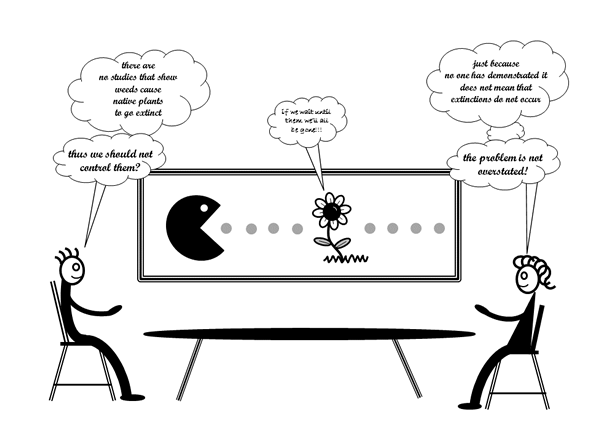15 August 2016 | By Paul Downey and Dave Richardson

Alien plants are widely recognised as a global threat to biodiversity. Many invasive plant species have transformed the structure and functioning of ecosystems. Although hundreds of alien plant species are widespread invaders, there are no documented examples of native plants that have gone extinct solely as a result of alien plants, even for widespread invaders like Port Jackson willow (Acacia saligna) and rooikrans (Acacia cyclops).
The lack of documented evidence of extinctions (i.e. the total elimination of a species from its native range) has led some authors to question whether the threat posed by alien plant invasions to biodiversity has been overstated and whether expensive management operations to control such invasions is justified. Others have argued that the absence of documented examples of native plant extinctions does not mean that extinctions have not occurred, or that extinctions could not occur in the future, and that management of plant invasions is critical to ensure biodiversity conservation. This debate is somewhat esoteric and confusing to the public, managers and to policy makers.
There are several reasons for the debate on this issue. Firstly proving that every last individual of a plant species has been lost (i.e. gone extinct) is extremely difficult, especially for species which have long-lived seed banks in the soil, or can regenerate from underground structures. The extinction of a species is the culmination of a sustained level of threat across the entire distribution of a species, over a prolonged period. Thus, to demonstrate that alien plants cause the extinction of native plants requires a series of conditions to be met, many of which are either not measured, or have not been examined for long enough.
Also, there is often a substantial time lag between the introduction of an alien species and the manifestation of impacts attributable to invasions of that species. This results in an “extinction debt” — effects that place species firmly on a trajectory towards extinction which will take time to manifest. Whereas many invasive animals (such as predators on islands) have caused extinctions of native animals very soon after the invaders arrived, processes leading to extinction in plants are orders of magnitude slower.
The control of alien plant invasions and restoration of invaded sites in many parts of the world has also probably halted the decline of native populations, or has offset potential extinctions, for many native plant species.
Focusing the debate on the impact to biodiversity from alien plant invasions solely on EXTINCTIONS (the end point of an extinction trajectory) has meant that the effects of invasive plants on key process that drive species along the extinction trajectory have not been given due attention in many assessments of the global impact of invasive plant species on biodiversity.
A study by C·I·B Visiting Fellow Paul Downey (Institute for Applied Ecology, University of Canberra) and C·I·B Director Dave Richardson reviewed the evidence for impacts of alien plant invasions on native plant species worldwide. They identified six thresholds along the extinction trajectory of plant species affected by invasive plants. Although they found no evidence for EXTINCTIONS driven solely by plant invasions, they found abundant evidence for progression along the extinction trajectory driven by the effects of invasive plants.
“The main reason that there is no clear evidence of extinction that can be exclusively attributed to plant invasions is that invasions have not been around long enough” says Dave Richardson. “Our research shows that plant extinction is an agonizingly slow process” he adds. “However, red flags are evident in numerous locations around the world — species that now exist in fragmented populations, with radically reduced opportunities to reproduce”.
“If we wait until we have sufficient evidence to show that extinctions are occurring, it will be too late to save a great number of species” as Paul Downey explained. “Also, land managers need to know when to undertake alien plant control to protect declining native plants before it is too late.”
Dave Richardson adds “Using only information on extinction rates when assessing the impacts of plant invasions on native plant species is extremely short-sighted. There is absolutely no doubt that alien plant invasions are eating away at native plant biodiversity. Many native plant species – probably HUNDREDS of species – are precariously close to being functionally extinct and survive as the ‘living dead’”.
“The results of this work show that we must shift attention away from the end point of the extinction trajectory, to give due consideration of the full series of processes that drive declines of populations of native species” says Paul Downey. “We need a radical overhaul of the indicators used to track the impacts of plant invasions.”

| Threshold no. | Description |
| 1 | the local loss of individuals such that (deaths (D)) exceeds births (B) plus the combined effect of immigration (I) minus emigration (E) (i.e. resulting in an overall reducing population size) based on N1 = N0 + (B-D)+(I-E). Note: alien plants could decrease the population by also reducing birth and immigration rates. |
| 2 | no living individuals occur in one or more discrete populations (i.e. former populations), but propagules occur in the seedbank. Individuals occur in other populations |
| 3 | the extinction of one or more populations in the wild (i.e. no individuals or propagules in the seedbank occur), which could be considered as a “local extinction” — but other populations exist which may be fragmented in the landscape |
| 4 | no living individuals occur (i.e. across all populations), but propagules (see above) occur in the seedbank in some populations |
| 5 | the extinction of the species in the wild (i.e. no individuals or propagules in the seed bank occur anywhere in the wild); individuals and/or propagules may occur ex-situ |
| 6 | species extinction — the complete loss of all individuals and propagules |
For more information, contact Paul Downey at paul.downey@canberra.edu.au or Dave Richardson at rich@sun.ac.za



